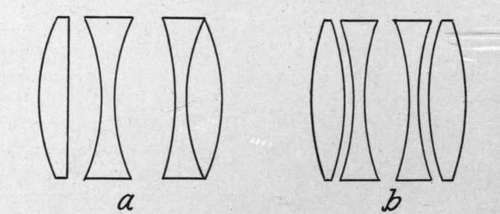Distortion
Description
This section is from the book "Airplane Photography", by Herbert E. Ives. Also available from Amazon: Airplane photography.
Distortion
Sometimes a lens is relatively free from all the aberrations, mentioned above, so that it gives sharp, clear images on the plate, yet these images may not be exactly similar to the objects themselves as regards their geometrical proportions; in other words, the image will show distortion. Lens distortion assumes two typical forms, illustrated in Fig. 13, which shows the result of photographing a square net-work with lenses suffering in the one case from "barrel" distortion and in the other from "pin-cushion" distortion. In the first the corners are drawn in relative to the sides; in the latter case the sides are drawn in with respect to the corners. Either sort is a serious matter in precision photography, such as aerial photographic mapping aspires to become. It must be reduced to a minimum and its amount must be accurately known if negatives are to be measured for the precise location of photographed objects. In general symmetrical lenses give less distortion than the unsymmetrical (Fig. 14).

Fig. 14. - Arrangement of elements in two lenses suitable for aerial work: a, Zeiss Tessar; two simple and one cemented components (unsymmetrical); b, Hawk-eye Aerial; two positive elements of heavy barium crown, two negative of barium flint, uncemented (symmetrical).
Continue to:
Tags
camera, lens, airplane, aerial, film, exposure, photography, maps, birdseye
